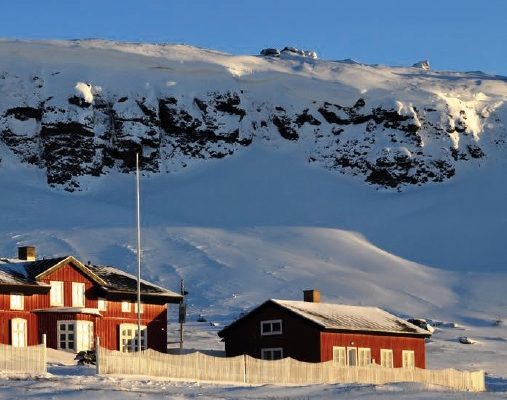Arctic Station

Address
Arctic Station3953 Qeqertarsuaq
Greenland
Station manager
Aart KroonStation Features
Opening year: 1906 Status: OpenFacilities
Station name and owner
Owner of the Arctic Station in Greenland is the Faculty of Science at the University of Copenhagen, Denmark.
Location
The Arctic Station is located on the south coast of the Disko Island in central West Greenland (69°15’ N, 53°34’ W). It is facing the Disko Bay/Davis Strait and is characterised by a low arctic, coastal climate. Some of the world’s largest icebergs drift by the Arctic Station .
Climate data
Grey colours are WMO Climate Normals including maximum and minimum values. Blue colours are individual years.
Climate data for the stations where extracted via Copernicus Climate Data Store, from the global gridded reanalysis product:
ERA5 monthly averaged data on single levels from 1940 to present.
Description and source code: Roemer J.K. 2023. https://doi.org/10.5281/zenodo.10214922
Data Source: Hersbach et al. 2023. Copernicus Climate Change Service (C3S) Climate Data Store (CDS), https://doi.org/10.24381/cds.f17050d7
Biodiversity and natural environment
The surroundings of Arctic Station are characterised by a large variety in landscape, flora, and fauna. The station and the nearby town Qeqertarsuaq are situated on a ridge of Precambrian gneisses overlain by massive basalts from the Tertiary. The surrounding mountains have an altitude of 600-800 m a.s.l. Three major valley glaciers, Lyngmarksbræen, Chamberlain’s Glacier, and Petersen’s Glacier, can be visited on a single day trip. The area around Qeqertarsuaq is situated in the transition zone between continuous and discontinuous permafrost. A large variety of periglacial phenomena can be studied, i.e. ice- and sand wedges, stone polygons, mud circles, as well as palsa and pingo formations. The coastline is situated only 300 m south of the station along a 100 m wide sandy coastal barrier. The vegetation within the immediate surroundings of the Arctic Station is unique to low arctic Greenland. This is illustrated by the number of species of flowering plants within walking distance from the station: 212 of the 513 Greenlandic flower species occur in the area. This plant diversity is caused by a relatively favourable local climate, a high altitudinal gradient, rich soils, and several homothermic springs.
History and facilities
The botanist Morten Petersen Porsild founded the Arctic Station (“Den Danske Arktiske Station”) in 1906. The locality selected was c. 1 km east of the town Qeqertarsuaq (formerly Godhavn) which is located on the south coast of the Disko Island – also named Qeqertarsuaq. The idea of establishing an arctic research facility in Greenland was supported by famous explorers of the northern polar regions, e.g. Knud Rasmussen, Ludwig Mylius-Erichsen, and Fridtjof Nansen. The University of Copenhagen became the owner of the research facility in 1953. Arctic Station has around 150 Danish and international visitors, students, and researchers each year. Arctic Station has rooms for 26 people. Kitchen, living room, seminar room, scientific library, and laboratories are found at the station.
General research and databases
The surroundings of Arctic Station offer both terrestrial and marine environments, which makes the research station ideal for botanists, zoologists, geologists, geophysicists, and physical geographers. A meteorological station was established in 1990, and a full record of climate data exists since 1991. These monitoring data are available through Dr. Birger Ulf Hansen, University of Copenhagen, Institute for Geology and Geography (buh@ign.ku.dk).
Link to data: https://dataportal.eu-interact.org/stations
Station Monitoring
Human dimension
Arctic Station is located only 1 km east of the town Qeqertarsuaq (Godhavn) with a population of around 1000 inhabitants. The city was established in 1773 by Sven Sandgren. Whaling has always been very important for the city. Fishing and hunting are still among the primary occupations for the island’s inhabitants. Tourism is another major business. As something quite unique for Greenland, it is possible to ride a dog sledge on the local glaciers at Qeqertarsuaq under the midnight sun during summer. One can hike to the top of the Lyngmarksfjeld where efforts are rewarded by a fantastic view of Disko Bay and the gigantic icebergs at Ilulissat Icefjord almost 100 kilometres away.
Access
The Arctic Station can be visited without problems throughout the year. Qeqertarsuaq Heliport is served in winter by the Bell 212 helicopter. Air Greenland operates winter-only air services from Qeqertarsuaq Heliport to Ilulissat, Qasigiannguit, and Aasiaat. During summer and autumn, when the waters of Disko Bay are ice-free, transport between towns and settlements is by sea only. A ferry (Diskoline) links Qeqertarsuaq with Ilulissat, Aasiaat, and Qasigiannguit. For further information see www.diskoline.gl.


